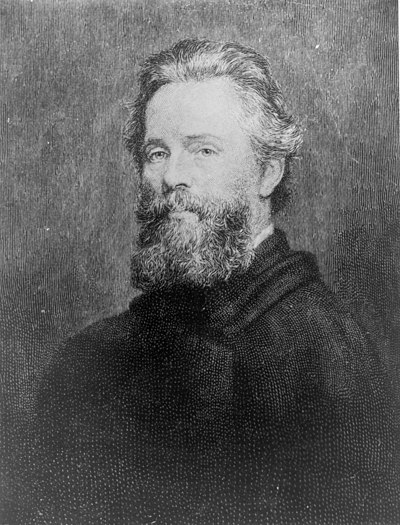Difference between revisions of "Herman Melville and Adoption"
(Created page with "{{#eimage: http://upload.wikimedia.org/wikipedia/commons/thumb/f/f1/Herman_Melville.jpg/400px-Herman_Melville.jpg |410x579px|thumb|'''Herman Melville, 1870. Oil painting by Jo...") |
(No difference)
|
Revision as of 19:48, 22 March 2014
Biography
Melville was born into a comfortably well-off merchant family in New York, but his father went bankrupt and insane, and died when he was 12 (other sources say 14), leaving his mother a widow with eight children. At 15 he was working, variously as bank clerk, farm laborer and teacher, before going to sea at 19 (or 18).
During a voyage in 1842 to the Marquesas in the South Pacific he and a friend jumped ship and for the next few years lived there among the Typee people, then "notorious cannibals." He was adopted by a chief and married his daughter, Pe'ue.
His experiences formed the background for his novel Typee (published 1846), but were generally believed to be fictional until a century later, when anthropologists working in the Marquesas found the entire incident corroborated in Typee oral history. Melville's other novels include Omoo, and Moby-Dick, often considered the finest novel ever written by an American.
References
Microsoft Encarta 98 Encyclopedia, 1993-97 Melville, Herman. Typee. Numerous editions Sacks, Oliver. The Island of the Colour-Blind; and Cycad Island. (London: Macmillan, 1996), p. 250 Parker, Hershel. Herman Melville: A Biography. (Baltimore: John Hopkins University Press, 1996)
- Adoption Celebrities
- Adopted Persons
- European
- French Overseas Departments and Territories
- USA
- 19th Century
- Literature
- Trades (carpentry, Catering, Merchant Marine)
- Sexuality: Gay Men, Lesbians, Bisexuals, Transsexuals
- Homelessness, Drifting
- Adopted as an Adult
- Honorific Adoptions
- Others ("Strangers")
- Wealthy, Famous, Noble or Divine Adoptive or Foster Families
- Trans-Racial, Trans-Tribal, International or Trans-Cultural Adoption or Fostering
- Customary or Traditional Adoption, Informal and Extra-Legal Care
- Adoptees/Fosterees from Wealthy, Famous, Noble or Divine Birth Families
- Parent(s) Died, Disappeared or Became Incapacitated
